Nifca and Molta plate folders
Nichidoku Shashinki Shōten, later Molta Gōshi-gaisha then Chiyoda Kōgaku Seikō (the predecessors of Minolta), made a series of 6.5×9cm folding bed plate cameras from 1930 to the war. These are the Nifcaklapp (ニフカクラップ), Nifcasport (ニフカスポート), Sirius (シリウス), Arcadia (アルカデア), Eaton (イートン), Lomax (ロマックス) and Happy (ハッピー).
All have a metal body, a swivelling brilliant finder and a wireframe finder. They have double extension bellows driven by a wheel or worm screw placed on the photographer's right, and have a distance scale on the left. The various models differ by the focusing mechanism, the movement abilities and many other details.
This page only treats the folding bed models. See also the Nifca-Dox, Minolta and Auto Minolta, and Auto Press Minolta strut-folding cameras.
Contents
Nifca period
Nichidoku used the brand name "Nifca", coming from Nichidoku Foto Camera.[1] Nichi in Nichidoku means Japan, and it is certainly not coincidental that "Nifca" can also be read as Nippon Foto Camera. The Nifca range consisted of the Nifcaklapp and Nifcasport folding bed models, in addition to the Nifcarette 4×6.5 rollfilm camera and the Nifca-Dox strut folder. The Nifcaklapp and Nifcasport were both released in 1930.[2]
Nifcaklapp
The Nifcaklapp[3] (ニフカクラップ) is the less advanced model. It has a focusing wheel turning on a longitudinal axis, certainly driving the front standard via a worm gear. The lens standard, made of pressed metal, is pulled out by two cylindrical posts, and gives no movement ability. The folding bed is held in closed position by two pins and is opened by pressing two buttons simultaneously, one at each side of the body. The frame finder has a round black eyepiece on the rear.
The Nifcaklapp appears in a full-page advertisement in Asahi Camera May 1930, with the English catch phrase "Nifcaklapp is better".[4] The format is mentioned as daimeishi (6.5×9cm), and the price is ¥39 with an Anastigmat 105/6.3 lens. The picture shows a camera with a dial-set Vario shutter and perhaps a Wekar-Anastigmat lens. The pulling posts at the bottom of the front standard are larger than on the other known pictures, the wireframe finder has no indent at the bottom, and the brilliant finder perhaps has a bubble level attached to the side.
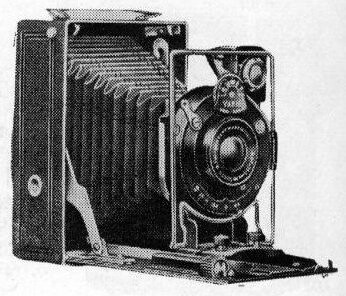
|
| Nifcaklapp, Vario shutter, 105mm f/6.3 lens by Kenngott. From Shashin Kōgyō September 1958. (Image rights) |
The advertisement in Asahi Camera January 1931 presents the Nifca range but gives almost no detail.[5] It shows a different picture, which was reproduced in many later sources, including an early historical article by Chiyoda Kōgaku Seikō (predecessor of Minolta) in Shashin Kōgyō September 1958.[6] The camera differs from the previous one by minor details: the pulling posts at the bottom of the front standard are smaller and the wireframe has an indent at the bottom. The shutter is a dial-set Vario again, giving 25, 50, 100, B, T speeds. The lens is a 105mm f/6.3 made by Kenngott but its name is not legible; it has a number in the 503xx range.
The chronology compiled by Chiyoda Kōgaku Seikō (predecessor of Minolta) and published in Shashin Kōgyō September 1958 gives the following list of lens and shutter combinations:[7]
- Wekar[8] Anastigmat 105/6.3 lens, Vario shutter (25–100);
- Wekar Anastigmat 105/6.3 lens, Ibsor shutter (1–125);
- Wekar Anastigmat 105/4.5 lens, Ibsor shutter (1–125);
- Wekar Anastigmat 105/4.5 lens, Compur shutter (1–200).
Some sources say that the price ranged from ¥39 to ¥69.[9]
One surviving camera is known with the plain wireframe (not indented) and perhaps the heavier pulling posts, certainly corresponding to an early example.[10] It has a bubble level to the side of the brilliant finder. The available pictures are very small and do not allow to tell the lens and shutter equipment.
Another surviving camera is pictured in Sugiyama, with the indented wireframe and smaller pulling posts.[11] It has a bubble level too. The shutter is a dial-set Vario and the lens is an Anastigmat Nifcaplan 105mm f/6.3 made by Kenngott.[12] The camera is very similar to the well-known picture described above, and the lens number is in the same 503xx range.
Nifcasport
The Nifcasport (ニフカスポート)[13] is a more advanced model. It has the same body as the Nifcaklapp, with the same folding struts and the same closing mechanism. The focusing wheel has a more usual transverse disposition and the focusing rails are more precisely machined, certainly providing double extension. The front standard provides vertical and horizontal movement ability, driven by two knobs. None of the pictures observed so far show a bubble level.[14]
The advertisement in Asahi Camera January 1931 shows a picture of a Nifcasport in extended position, but gives no other detail.[15] The camera has two cylindrical pulling posts, apparently similar to those of the late Nifcaklapp, and seems to have a rim-set Compur shutter.

|
| Nifcasport, Compur shutter, Wekar-Anastigmat lens. From Shashin Kōgyō September 1958. (Image rights) |
The best known picture is another retouched image, certainly used by the company for advertising purpose too. It appears in the September 1958 historical article, and in many later sources.[16] The camera differs from the previous one by some details: two handles replaced the pulling posts at the bottom of the front standard, and the wireframe has a different shape with a larger indent at the bottom to accommodate the two handles. The shutter is a dial-set Compur, and has a small plate marked Nifca Photo under the speed setting wheel. The lens is engraved Wekar-Anastigmat and the lens diameter probably indicates an aperture of f/4.5.
The official chronology published in September 1958 gives the following list of lens and shutter combinations:[17]
- Wekar Anastigmat 105/4.5 lens, Ibsor shutter (1–125);
- Wekar Anastigmat 105/4.5 lens, Compur shutter (1–200);
- Nifcar Double Anastigmat 105/4.5 lens, Compur shutter (1–200).
The historical article published in the same magazine says that the version with Nifcar lens and Compur shutter cost ¥90;[18] another source says that the prices were ¥75, ¥85 and ¥90.[19]
The best known surviving example was belonging to the Minolta Gallery in the 1980s,[20] and is probably still the property of the Konica Minolta or Sony company. It is pictured in various sources, and is easily recognized because it is lacking the hinged wireframe and the front standard has a broken or missing part, revealing the gearing mechanism for vertical movements.[21] It has a Compur shutter (T, B, 1–250) and is said to have a Wekar f/4.5 lens.[22]
Another surviving example is known with the two pulling handles. It has yet another type of wireframe finder, with an indent at the bottom but no offset at the hinge.[23] The available pictures are very small and do not allow to tell the lens and shutter equipment.
Molta period
The company became Molta Gōshi-gaisha in 1931 and the name Nifca was consequently abandoned. The Nifcaklapp and Nifcasport were respectively renamed Sirius and Arcadia, and name variants were distributed by Misuzu Shōkai respectively as the Lomax and Eaton. Many sources, based on early historical accounts by the Chiyoda or Minolta company, say that the Sirius, Arcadia, Eaton and Happy were released together in 1931, and omit the Lomax.[24] This is probably wrong of the Happy, distributed by Asanuma Shōkai, which certainly appeared a few years later (see below).
Sirius and Lomax
 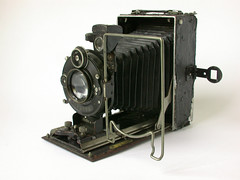 
|
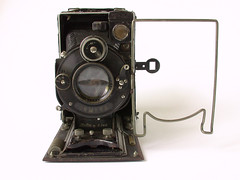 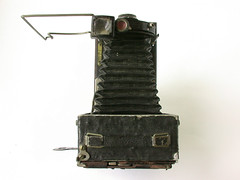 
|
| Sirius no.6346, Compur shutter (T, B, 1–250), Thowe Doppel Anastigmat 12cm f/4.5 lens no.49825. Pictures by A. Apra. (Image rights) |
Description

|

|

|

|
| Double extension bellows. (Image rights) |
Focusing worm-screw. (Image rights) |
The Sirius (シリウス) was a continuation of the Nifcaklapp, and the Lomax (ロマックス) is a name variant. The focusing mechanism now allows double extension, and is driven by a long worm screw (as on the Nifcarette A). The distance scale is on the left and goes down to 1m.

|
| Distance scale. (Image rights) |
The top handle is modified, with metal ends and lugs placed in an outer position. On most cameras, the eyepiece is the same as on the Nifca models, with a round shape; at some time it was replaced by a newer shield-shaped eyepiece, the same as on the Arcadia and Happy. The wireframe has an indent at the bottom, and is the same as on the late Nifcaklapp. The front standard has two small pulling posts, and is very similar to that of the late Nifcaklapp too. The body serial number is inscribed at the bottom, and the Sirius cameras have an additional Molta logo, absent on the Lomax.
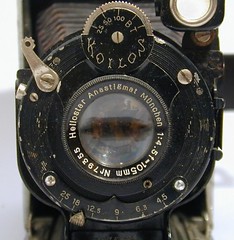
|
| Koilos shutter, Heliostar Anastigmat 105mm f/4.5 lens on a Lomax. Picture by eBayer hbpartner. (Image rights) |
 
|
| Left: early closing pins; right: later closing slit. (Image rights) |
The early Sirius cameras have the same closing mechanism as the Nifca models, with two pins on the folding bed, released by a button on each side of the body. Later Sirius and Lomax cameras have a single latch spring, engaging a rectangular slit in the focusing board.
The camera normally has a dial-set Koilos shutter, giving 25, 50, 100, B, T speeds, and a Heliostar lens, whose origin is unclear (see the corresponding page). Despite the drop of the "Nifca" name, the Sirius has a small plate inscribed Nifca Photo under the speed setting wheel, the same as on the Nifcasport.
Advertisements and other documents
The Sirius appears in a full-page advertisement placed by Molta in Asahi Camera July 1932.[25] The shutter name is not mentioned, but the camera is pictured with a Koilos and the description of the features does fit. Two versions are mentioned, with a Heliostar Anastigmat f/6.3 or f/4.5 lens, respectively priced at ¥38 and ¥48, including three plate holders, an "adapter" (アダプター, perhaps a pack holder), a cable release and a Molta exposure table. The pictured camera has the early closing mechanism.
Other advertisements are known, surely placed in Ars Camera. They only list the version with Heliostar Anastigmat f/6.3 lens, and they mention the Koilos shutter name. The price is either ¥35 or ¥40, depending on the date.[26] The picture is not the same as in the July 1932 advertisement cited above, but the camera shows no noticeable difference.
The Lomax appears in an advertisement by Misuzu Shōkai in Asahi Camera, at an unknown date.[27] It is presented together with the Eaton (see below). The name is displayed both in Roman letters and in katakana script (ロマックス). The pictured camera is clearly identical to the Sirius with the late closing mechanism. The description mentions the Koilos shutter and lists two versions with a Heliostar Anastigmat f/6.3 or f/4.5 lens, respectively priced at ¥30 and ¥40, including three plate holders, a film pack holder and a cable release. The lower price might suggest that the Lomax was released to dispose of a stock of Sirius bodies, removing the Nifca Photo and Molta inscriptions.
The Sirius only appears with the f/6.3 lens in the September 1958 official chronology cited above.[28] The Lomax was forgotten by the company in its historical accounts, and is extremely little known today.
Surviving examples
At least two surviving examples of the Sirius are known with the Heliostar f/6.3 lens and the early closing mechanism. The body numbers are 5854 and 6284, and the lens numbers are in the same 73xxx range.[29] The lens engraving is M. Steinheil München Nr73xxx Heliostar 1:6.3 f=105mm, corresponding to an early batch of Heliostar lenses, perhaps related to the Steinheil company (see the discussion in Heliostar).
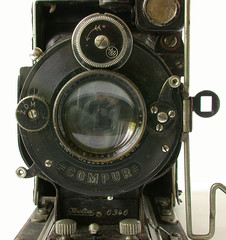 
|
| Sirius no.6346, Compur shutter (T, B, 1–250), Thowe Doppel Anastigmat 12cm f/4.5 lens no.49825. Pictures by A. Apra. (Image rights) |
Another example (body no.6346) is known with the early closing mechanism, a dial-set Compur shutter (T, B, 1–250) and a Thowe Doppel Anastigmat 12cm f/4.5 lens. It is not known for sure if this lens and shutter equipment is original or not. The name Sirius is embossed in the leather of the folding bed. The ground glass hood has the logo of Nichidoku, with the letters N, D, PH and Co assembled inside a circle.
One example of the Sirius is pictured in Sugiyama and Francesch with the newer closing mechanism and a Heliostar Anastigmat 105mm f/4.5 lens.[30] The body number has four or five digits, beginning with "7422", and the lens number is in the 74xxx range.
 
|
 
|
 
| |
| Lomax no.75692, Heliostar Anastigmat 105mm f/4.5 lens no.79355, Koilos shutter. Pictures courtesy of eBayer hbpartner. (Image rights) | |
Finally, the example pictured in this page with a Heliostar Anastigmat 105mm f/4.5 lens is most certainly a Lomax. It has no Molta or Nifca Photo marking on the front standard and shutter face, has no embossing on the folding bed, and has the name Lomax embossed in the ground glass hood. It comes with a film pack adapter embossed Minolta, normally found on the Minolta and Auto Minolta strut-folding models. The body has the newer closing mechanism and the newer shield-shaped eyepiece, and is missing the wireframe. The body number is 75692 and the lens number is 79355.
 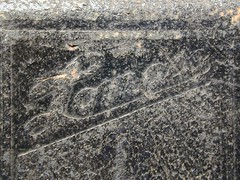
|
| Body no.75692, Lomax embossing, no Molta marking. Pictures by eBayer hbpartner. (Image rights) |
Original case
The case pictured below is certainly an original accessory. It has the same lock as other cases for contemporary Molta cameras, with a TOKYO inscription.
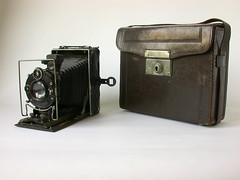 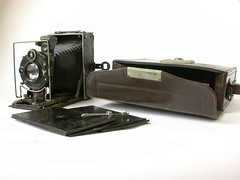
|
| Sirius no.6346 with original case. Pictures by A. Apra. (Image rights) |
Arcadia and Eaton
Description
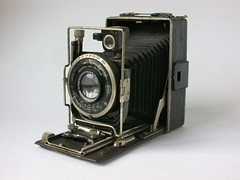  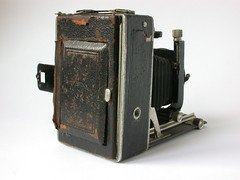
|
 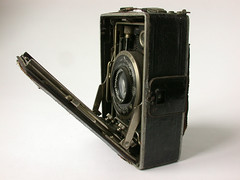 
|
| Arcadia no.75901, Lidex shutter (T, B, 1–200), Anastigmat Trioplan 10.5cm f/4.5 lens no.574449. Pictures by A. Apra. (Image rights) |

|
| Distance scale of no.75901. (Image rights) |
The Arcadia (アルカディア) was a continuation of the Nifcasport, and the Eaton (イートン) is a name variant. The focusing board is less heavily machined than on the Nifcasport, and the handles at the base of the front standard were replaced by two pulling posts. The distance scale is on the left and goes down to 1m. The camera has the same vertical and horizontal movement abilities as the Nifcasport, with dots indicating the neutral position.
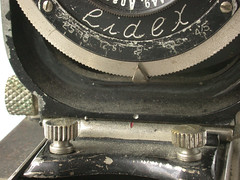 
|
| Details of the front standard, showing the movement controls, brilliant finder and bubble level (left: no.75901, right: no.75958). Pictures by A. Apra. (Image rights) |
The folding bed is normally held in closed position by a spring latch engaging a rectangular slit in the focusing tray and focusing rails. The serial number is engraved on the focusing tray, immediately above the slit.
 
|
| End of the focusing tray, showing the serial number and closing slit, and ARCADIA marking on no.75958. Pictures by A. Apra. (Image rights) |
The camera normally has a shield-shaped eyepiece, the same as on the Happy. Most cameras have a specific type of wireframe, with a shallow indent at the bottom and an offset portion on the side opposite the hinge, to leave space for the shutter release. The handle lugs are in the outer position, as on the Sirius and Happy. The Arcadia are identified by the name ARCADIA embossed in the leatherette of the folding bed; it is not known if the Eaton are marked as such or not.
 
|
| Early vs later struts. (Image rights) |
At least one important change occurred during the production run (see below for the minor variations): the early cameras have the same struts as on the Nifca and Sirius models; on the late cameras these were replaced by larger struts with a more intricate design, the same as on the Happy.
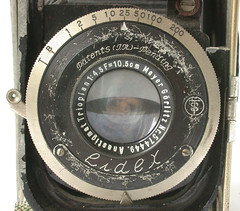
|
| Lidex (T, B, 1–200) and Anastigmat Trioplan 10.5cm f/4.5 lens no.574449 on the Arcadia no.75901. Picture by A. Apra. (Image rights) |
The camera normally has a rim-set Lidex shutter made by the Molta company, giving 1–200 or 5–200 speeds. This shutter challenges the Magna by Seikōsha for the title of first Japanese leaf shutter. The shutter plate is marked Lidex at the bottom and has the MTS logo on the right; it has a mention of patents at the top. The lens is either a Heliostar[31] Anastigmat 105mm f/4.5 of unclear origin or an Anastigmat Trioplan 10.5cm f/4.5 by Meyer (see below).
Advertisements and other documents
No original advertisement for the Arcadia has yet been observed. Some sources say that the price was ¥40.[32] However this price is very dubious: it is close or similar to that of the Sirius f/6.3, and lower than that of the Sirius f/4.5.[33]
The Eaton appears in the advertisement by Misuzu Shōkai in Asahi Camera, already mentioned above for the Lomax.[34] The name is displayed both in Roman letters and in katakana script (イートン). The pictured camera is identical to the Arcadia with the early struts. It has a Lidex shutter (T, B, 1–200) and a Heliostar Anastigmat 105mm f/4.5 lens. In the description, the speed range of the Lidex is given as T, B, 10–200, perhaps by mistake, and the lens is called Lomax Anastigmat (ロマックスアナスチグマット). The price is ¥60, including three plate holders, a film pack holder and a cable release.[35]
Neither the Arcadia nor the Eaton is listed in the September 1958 official chronology cited above.[36] The two cameras were certainly added to later historical accounts published by the Minolta company, and are mentioned in various Western sources. The Eaton is usually listed as having a Coronar 105mm f/4.5 lens and a Crown A shutter, certainly after some official company history;[37] however no original document has been found so far to sustain this.
Early camera, perhaps experimental
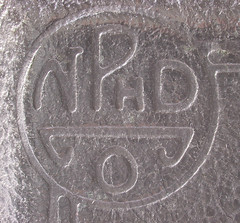
|
| Nichidoku logo on the ground glass back of the Sirius no.6346. Picture by A. Apra. (Image rights) |
One extremely early example of the Arcadia is pictured in an article by Andō in Camera Collectors' News, differing from the regular Arcadia in various points.[38] It has the older round eyepiece, inner handle lugs and two-pin closing mechanism, the same as on the Nifcasport. No movement ability is visible on the front standard, either because of missing parts of because the knobs controlling the rise and cross movements were intentionally removed. Some additional cylindrical part is visible behind the focusing wheel, perhaps corresponding to a focus lock; this is found on a few other Arcadia (see below). The ground glass back has the round Nichidoku logo. (This does not necessarily mean that the camera was made before the company name became Molta. The older brand name and logo persisted on some parts for a short time, certainly to use older stocks: see the Nifca Photo marking on some Sirius cameras with Koilos shutter, or the presence of a similar Nichidoku ground glass hood on another Sirius camera.)
The camera is also distinguished by its Neuheil shutter (5–150, B, T). The shutter plate is inscribed Optik & Feinmechanik and JAP. PAT. APPL. FOR at the top in small characters, and Neuheil at the bottom. This is the oldest example of Neuheil shutter known so far; it shows no mention of the manufacturer's name Neumann & Heilemann. The lens is a Heliostar Anastigmat 105mm f/4.5 (no.75739).
The shutter equipment is particularly strange. Neumann and Heilemann founded their shutter factory in 1932; before that, Heilemann had left the Molta company in November 1931, and Neumann followed him the next year, dragging some employees with him.[39] Tashima Kazuo (founder of Nichidoku, then Molta) said in his autobiography that this "was a shock so big you cannot tell", and probably did not remain on very good terms with them.[40] It seems very unlikely that the Molta company deliberately bought Neuheil shutters to mount on the Arcadia, while it was preparing its own Lidex shutter. Various hypotheses can be drawn:
- this camera was taken by Neumann, Heilemann or an employee who followed them, and was used as an experimental camera by the new company to test the Neuheil shutter; such prototypes are likely to have existed, and one of them might have survived by chance;
- this camera was assembled by the Molta company, to test the Neuheil shutter newly produced by its new competitor, e.g. to compare it with the Lidex; this hypothesis is unlikely because the camera would certainly have been refitted with a Lidex and dispatched for sale after the tests;[41]
- the camera is a very early Arcadia whose lens and shutter unit was swapped for that of another camera, for example a Weha, known to have used the Heliostar and Neuheil combination; this hypothesis has the merit of simplicity;
- the Neuheil shutter was developed inside the Molta company, before Heilemann left in November 1931, and was mounted on a small batch of Arcadia cameras; this would explain the absence of the company name Neumann & Heilemann on the shutter, but "Optik & Feinmechanik" sounds like a temporary label adopted by the infant company, and seems very unlikely on a Molta product.
Other surviving examples
  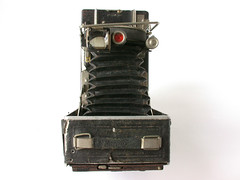
|
| Arcadia no.75958, Lidex shutter (T, B, 5–200), Anastigmat Trioplan 10.5cm f/4.5 lens no.574432. Pictures by A. Apra. (Image rights) |
All the other known examples have the shield-shaped eyepiece, spring latch closing mechanism and outer handle attachments described above. All have a Lidex shutter to 1/200, usually with 1s low speed.
The early cameras are recognized by the older struts. All of these have the words Patents(J.N.)–Pending at the top of the shutter plate. At least two examples have some cylindrical part behind the focusing wheel, perhaps an infinity lock, the same as on the experimental example described above; one of them is confirmed to have the Heliostar 105mm f/4.5 lens.[42] These are certainly among the earliest cameras; none of the subsequent examples has this part.
 
|
| Serial numbers 75901 and 75958. (Image rights) |
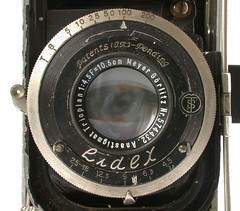
|
| Lidex (T, B, 5–200) and Anastigmat Trioplan 10.5cm f/4.5 lens no.574432 on the Arcadia no.75958. Picture by A. Apra. (Image rights) |
At least two early examples are known with an Anastigmat Trioplan 10.5cm f/4.5 lens by Meyer.[43] The two cameras belong to the same batch: the body numbers are in the 759xx range and the lens numbers are in the 5744xx range. They nonetheless differ by the range of speeds: 5–200 or 1–200.
The other early examples are presumed to have the Heliostar f/4.5 lens; one of them is reported as an Eaton.[44] Minor variations are visible in the milling of the rise and cross movement knobs, but no pattern has been detected.
The late cameras have the newer struts. It seems that the shutter marking became Patents–Nippon some time after.[45] One late example, with the newer Patents–Nippon marking, was kept by the Minolta company, at least until a recent time.[46] (On occasions, that camera has been pictured with a different wireframe, the same as on the Happy, with a large indent at the bottom, a diagonal indent at the top for the brilliant finder, and no offset portion.[47] The wireframe was perhaps swapped at some time, then replaced by the correct part for later pictures.)
Ever-ready case

|
| Logo on the case latch. (Image rights) |
One of the surviving examples comes with an ever-ready case which was certainly made specially for the camera, and was perhaps an original accessory sold by Molta. The latch has a logo picturing a dog with the word LOCK and the letters DY in a diamond.
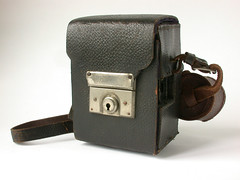 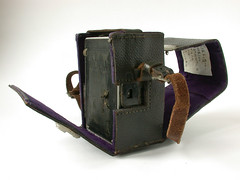 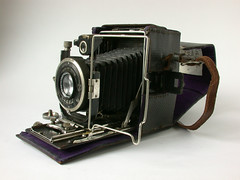
|
| Arcadia no.75958 in its ever-ready case. Pictures by A. Apra. (Image rights) |
Happy
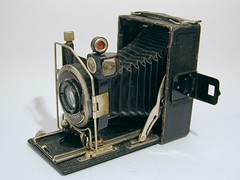 
|

|

|

|

| |
| Happy no.6647, Coronar Anastigmat Nippon 105mm f/4.5 lens no.103001, Crown shutter, no self-timer. Pictures courtesy of eBayer hbpartner. (Image rights) | ||
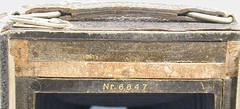
|
| Serial number inside the back. (Image rights) |

|
| HAPPY name embossed in the ground glass hood. (Image rights) |
Description
The Happy (ハッピー) was an evolution of the Arcadia, from which it mainly differs by the absence of horizontal movements and by the new pulling handles at the bottom of the lens standard. The folding struts are the same as on the late Arcadia; the closing mechanism is similar, but is actuated by a single button on the side. The brilliant finder with bubble level and the viewfinder eyepiece are the same as on the Arcadia. The wireframe normally mounted on the camera has a new shape, with a large indent at the bottom and a diagonal cut-off at the top, to clear the way to the brilliant finder. The body serial number is engraved inside the back; it is not known if this feature was already present on the Arcadia. The name HAPPY is embossed in the leather of the folding bed and of the ground glass hood.

|
| Crown shutter, late shutter plate, Coronar Anastigmat Nippon 105mm f/4.5 lens. (Image rights) |
The Happy normally has a Coronar Anastigmat Nippon 105mm f/4.5 lens, made by Asahi Kōgaku (later Pentax).[48] The shutter is normally a version of the Crown made by Molta itself and giving T, B, 5–200 speeds, either without or with a self-timer.[49] The version with self-timer is called "Crown S" in various original documents;[50] that without a self-timer is called "Crown B" in an original document on the Minolta Six.[51] The Happy was among the first cameras entirely made in Japan, lens and shutter included.[52]
Release year
Early historical accounts by the Chiyoda or Minolta company, such as the chronology published in September 1958 or the fifty-year history book, say that the Happy was released in 1931, together with the Sirius and Arcadia, and this has been repeated in many sources.[53] Japanese authors have put this in doubt, and suggest 1933 as the release date instead.[54]
From the features of the camera itself, it seems that the Happy actually replaced both the Arcadia and Sirius. The camera was distributed by Asanuma Shōkai, which is known to have sold a Focal Happy at an earlier date and certainly owned the brand name "Happy". The Molta company certainly released the Happy after it entered an exclusive resale agreement with Asanuma, which would last until 1945. In July 1932, Molta was still placing its own advertisements for the Sirius, and the Happy certainly appeared later.
Early version with Lidex shutter and Heliostar lens
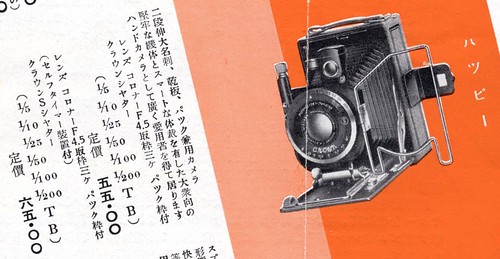
|
| Extract of a leaflet for the Minolta and Happy range dating c.1935. The lens marking faintly reads Heliostar Anastigmat München. Scan courtesy of A. Apra. (Image rights) |
It seems that the very early Happy were equipped with a Lidex shutter and Heliostar lens before Asahi Kōgaku began to supply the Coronar. One actual example, certainly among the earliest, is known with a Heliostar Anastigmat 105mm f/4.5 lens and a Lidex shutter (T, B, 5–200).[55] In the leaflet reproduced above, dating c.1935, the lens engraving on the picture probably reads Heliostar Anastigmat München rather than Coronar Anastigmat Nippon, despite the mention of the Coronar lens in the textual description.[56] In the same picture, the shutter name Crown is written with a non-standard typeface; this picture was perhaps originally showing a Lidex shutter and might have been retouched after the introduction of the Crown and Coronar combination.
Early original documents

|
| Happy in an advertisement dated 1935. Scan by A. Apra. (Image rights) |
No original document earlier than 1935 has been observed so far. Advertisements dated April to July 1935 show a picture of a Happy with a peculiar type of wireframe, having a large indent at the bottom but no diagonal cut-off at the top.[57] The lens and shutter names are not mentioned. The price is ¥55 for the regular model, and ¥65 with a self-timer.[58]
Later advertisements, from July 1935 onwards, show a different picture of a presumably later camera, with the diagonal cut-off in the wireframe.[59]
 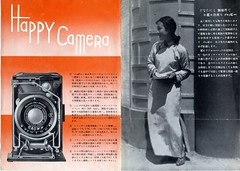
|
| Leaflet for the Happy, dating c.1935. The pictures show two different Happy cameras with Crown shutter and no self-timer. Scans courtesy of A. Apra. (Image rights) |
The leaflet reproduced above, dated c.1935, includes the same picture and shows another.[60] The cameras have a Crown shutter with no self-timer, and the words Patents(J.N.)–Pending are legible at the top of the shutter plate. Number 83561 is clearly legible on one of the Coronar lenses.
The leaflet reproduced below is dated c.1936 and shows the same picture again.[61] When mentioned, the prices are the same in all these documents: ¥55 and ¥65.

|
| Happy in the July 1938 catalogue and price list by Asanuma Shōkai. Scans by A. Apra. (Image rights) |

|
| Extract of a leaflet for the Minolta and Happy range dating c.1936. The picture is the same as in the first leaflet. Scan courtesy of A. Apra. (Image rights) |
Later original documents
The Happy was priced at ¥68 and ¥78 in the October 1938 catalogue by Asanuma Shōkai.[62] Advertisements for the camera are known as late as 1939, and it still appears in the official list of set prices compiled in October 1940 and published in January 1941, for ¥76.[63]
The Happy is mentioned in the introduction of the October 1941 catalogue by Asanuma Shōkai, presenting the Minolta range and the shutters equipping the various models; however it does not appear in the main pages, and it was perhaps not available for sale any more.[64]
Actual examples of the regular version
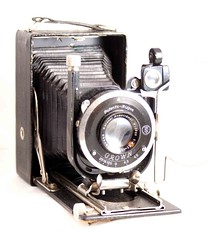  
|
| Happy no.1061, Coronar Anastigmat Nippon 105mm f/4.5 lens no.97829, Crown B shutter, no self-timer, early shutter plate. The body and lens numbers do not fit well together, perhaps because the lens and shutter unit was swapped at some time. Pictures courtesy of S. Montagna. (Image rights) |
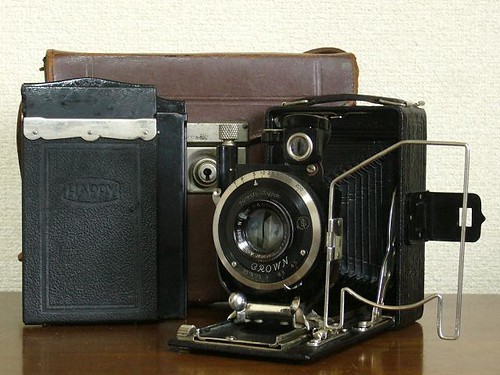
|
     
|
| Happy, Coronar Anastigmat Nippon 105mm f/4.5 lens no.997xx. Pictures by eBayer Yalluflex. (Image rights) |
  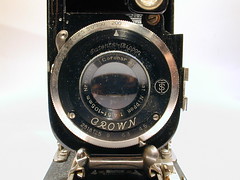
|
| Happy no.4419, Coronar Anastigmat Nippon 105mm f/4.5 lens no.97957, Crown B shutter, no self-timer, early shutter plate. Pictures courtesy of eBayer hbpartner. (Image rights) |
The regular examples have the Coronar lens and Crown shutter. Body numbers have been observed from 1061 to 6647, and lens numbers from 83543 to 107642. The cameras show little variations, mainly in the design of the shutter face. The first type of shutter plate has the name Crown directly engraved at the bottom and the MTS logo of Molta on the right. The early shutters have Patents(J.N.)–Pending at the top; this has only been observed on the Crown without a self-timer. This marking was replaced by Patents–Nippon at some time (towards lens no.87000), surely after the relevant patents were issued. Finally, the design of the shutter plate was completely renewed at some time (towards lens no.102000); the new type has three metal stripes added on each side of the lens, no MTS logo, the words PATENTS–NIPPON in capital letters at the top, and the name CROWN inscribed on a larger aperture scale screwed to the bottom. (A similar design change occurred on the Semi Minolta around 1937, shortly before the release of the Semi Minolta II; the change probably occurred simultaneously on the Happy.)
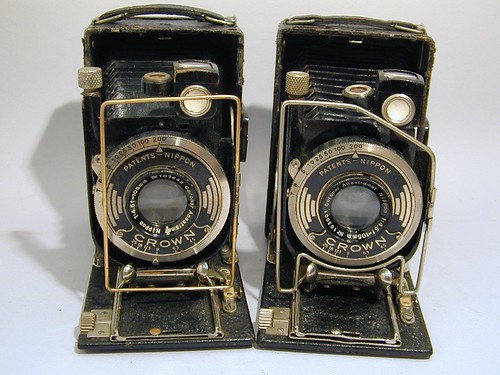
|
| Happy, Coronar Anastigmat Nippon 105mm f/4.5 lens, Crown shutter, no self-timer, late shutter plate. Left: body no.6402, lens no.107642 (non-original wireframe). Right: body no.6647, lens no.103001. Picture courtesy of eBayer hbpartner. (Image rights) |
The cameras also show minor variations in the position of the HAPPY logo embossed on the folding bed, which is either at the top or at the bottom. Some examples have a non-standard wireframe or finder eyepiece, but these are certainly not original.[65]
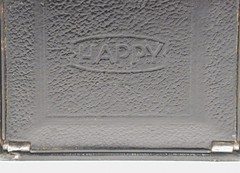 
|
| HAPPY marking on the folding bed, on body no.6402 (left) and body no.6647 (right). Pictures courtesy of eBayer hbpartner. (Image rights) |
Accessories
  
|
| Happy no.4419 with a ground glass back, a film pack holder, six plate holders and a leather case. Pictures courtesy of eBayer hbpartner. (Image rights) |
The Happy was normally supplied with a ground glass back, three plate holders and one film pack holder. The following accessories were sold separately:[66]
- filter holder with hood, ¥1.70 in 1938;
- set of three additional plate holders, ¥2.10 in 1938;
- leather case, containing the full set with 3 plate holders, ¥4 in 1938;
- leather case, containing the full set with 6 plate holders, ¥4.50 in 1938.
Notes
- ↑ See Francesch, p.17, and the Nifcarette page of the Konica Minolta website.
- ↑ "Hensen kamera ichiran-pyō", p.295 of Shashin Kōgyō no.77, reproduced in this Flickr page by Rebollo_fr. The 50-year history Minolta 50-nen no ayumi, p.65, specifies July 1930 for the Nifcaklapp and December 1930 for the Nifcasport; however an advertisement for the Nifcaklapp appears in Asahi Camera May 1930. The year 1930 is repeated in Tanimura, p.1 of the same, Awano, p.13 of Kurashikku Kamera Senka no.12, Eimukku 735 Minolta, pp.131–2, Francesch, p.70, Scheibel, p.11, Sugiyama, items 1181 and 1183, McKeown, pp.671–2, Baird, p.39.
- ↑ The name appears as a single word in the advertisement in Asahi Camera August 1930, reproduced in Hagiya, p.9 of Kurashikku Kamera Senka no.12.
- ↑ Advertisement reproduced in Hagiya, p.9 of Kurashikku Kamera Senka no.12.
- ↑ Advertisement reproduced in Awano, p.6 of Kurashikku Kamera Senka no.12.
- ↑ Early historical article: Taniguchi, p.275 of Shashin Kōgyō no.77, also reproduced in Tanimura, p.8 of Camera Collectors' News no.116. Other sources displaying the same picture: Awano, p.13 of Kurashikku Kamera Senka no.12, Francesch, p.70, Scheibel, p.8, Lewis, p.49, McKeown, p.671, and Baird, p.39. The reproduction in Scheibel is by far the most legible.
- ↑ "Hensen kamera ichiran-pyō", p.295 of Shashin Kōgyō no.77, reproduced in this Flickr page by Rebollo_fr. Francesch, p.71, gives a similar list but adds a fifth variant, with a Vario shutter and a Nifcaplan 105/6.3 lens, probably because he observed the surviving example having such combination. The mention of a Zeiss Anastigmat lens in McKeown, p.671, is surely a mistake.
- ↑ The names "Welka" in Lewis, p.45, and "Weker" in Sugiyama, item 1181, are mistakes.
- ↑ Minolta 50-nen no ayumi, p.65, repeated in Scheibel, p.11.
- ↑ Example pictured in Eimukku 735 Minolta, pp.131–2.
- ↑ Sugiyama, item 1183.
- ↑ The lens engraving is faintly readable as W. Kenngott Anastigmat Nifcaplan 1:6.3 F=105mm, and the name Nifcaplan is confirmed by the description in Sugiyama.
- ↑ The katakana spelling ニフカスポート (Nifukasupōto) was used in the January 1931 advertisement in Asahi Camera, reproduced in Awano, p.6 of Kurashikku Kamera Senka no.12. However the later Japanese sources use the spelling ニフカスポーツ (Nifukasupōtsu), following the common spelling of the word "sport" (スポーツ, supōtsu).
- ↑ Francesch, p.71, mentions a bubble level, perhaps by mistake. Only the picture in Asahi Camera January 1931 might show this feature, but the available reproduction in Awano, p.6 of Kurashikku Kamera Senka no.12, is too small to decide for sure.
- ↑ Advertisement reproduced in Awano, p.6 of Kurashikku Kamera Senka no.12.
- ↑ Early historical article: Taniguchi, p.275 of Shashin Kōgyō no.77, also reproduced in Tanimura, p.8 of Camera Collectors' News no.116. Other sources displaying the same picture: Awano, p.13 of Kurashikku Kamera Senka no.12, Scheibel, p.8, McKeown, p.672, Baird, p.40, and this page at infocam.co.kr (archived). The reproduction in Scheibel is by far the most legible.
- ↑ "Hensen kamera ichiran-pyō", p.295 of Shashin Kōgyō no.77, reproduced in this Flickr page by Rebollo_fr. Francesch, p.71, gives the same list. The mention of a Zeiss Anastigmat lens in McKeown, p.672, is surely a mistake again.
- ↑ Taniguchi, p.275 of Shashin Kōgyō no.77, also reproduced in Tanimura, p.8 of Camera Collectors' News no.116.
- ↑ Scheibel, p.11. Minolta 50-nen no ayumi, p.65, simply says ¥75 to ¥90.
- ↑ Sugiyama, item 1181.
- ↑ This camera is pictured in Francesch, p.70, and in Sugiyama, item 1181. A picture of this camera is in the 70th anniversary Minolta poster, reproduced in this page at Photoclub Alpha; poor reproductions of the same picture appear in this page of the Manual Minolta website, in this page of the Map Camera Museum (archived), and in this page of the Kitamura Camera Museum (archived).
- ↑ Shutter speeds and lens features: Sugiyama, item 1181. The focal length is given as 6.5cm, obviously by mistake.
- ↑ Example pictured in Eimukku 735 Minolta, pp.131–2.
- ↑ Only the Sirius and Happy are mentioned, with year 1931, in the official chronology "Hensen kamera ichiran-pyō", p.295 of Shashin Kōgyō no.77, reproduced in this Flickr page by Rebollo_fr. The 50-year history Minolta 50-nen no ayumi, p.65, specifies July 1931 for the Sirius, October for the Arcadia and Eaton, and December for the Happy. Year 1931 is mentioned for the Sirius, Arcadia, Eaton and Happy in Francesch, pp.20 and 72–3, Scheibel, p.13, Sugiyama, items 1184 and 1186–7, and McKeown, p.672. In Lewis, p.47, the Arcadia, Eaton and Happy are dated 1931. In Eimukku 735 Minolta, pp.131–2, the Sirius and Arcadia are dated 1931 and the Happy is dated 1932. In Awano, p.14 of Kurashikku Kamera Senka no.12, the Sirius, Arcadia and Eaton are dated 1931, and doubts are expressed about the Happy, temptatively dated 1933.
- ↑ Advertisement reproduced in Hagiya, p.9 of Kurashikku Kamera Senka no.12.
- ↑ ¥40: advertisement reproduced in Scheibel, p.13. ¥35: other advertisement observed at an unknown place. The price is given as ¥40 in the fifty-year history book Minolta 50-nen no ayumi, p.65, and in Scheibel, p.13.
- ↑ Advertisement reproduced in Awano, p.14 of Kurashikku Kamera Senka no.12.
- ↑ "Hensen kamera ichiran-pyō", p.295 of Shashin Kōgyō no.77, reproduced in this Flickr page by Rebollo_fr. Same information in Francesch, p.73 (nonetheless showing a picture of the f/4.5 model on p.72), and in Scheibel, p.13.
- ↑ Body no.5854, lens no.73230: example pictured in this page at Asacame. Body no.6284, lens no.73x25: example pictured in Awano, p.14 of Kurashikku Kamera Senka no.12.
- ↑ Sugiyama, item 1187, Francesch, p.72. The lens name "Helostar" in Francesch, p.73, is a mistake.
- ↑ The name "Helostar" in Francesch, p.73, and in McKeown, p.672, is a mistake.
- ↑ Minolta 50-nen no ayumi, p.65, repeated in Scheibel, p.13, and this page of the JCII collection.
- ↑ Minolta 50-nen no ayumi, p.65, and Scheibel, p.13, moreover give the same price of ¥40 for both the Sirius f/6.3 and the Arcadia f/4.5, which is extremely implausible.
- ↑ Advertisement reproduced in Awano, p.14 of Kurashikku Kamera Senka no.12.
- ↑ The price is given as ¥40 in Minolta 50-nen no ayumi, p.65, and Scheibel, p.13, but this is certainly an abusive generalization, from the price of the Arcadia.
- ↑ "Hensen kamera ichiran-pyō", p.295 of Shashin Kōgyō no.77, reproduced in this Flickr page by Rebollo_fr.
- ↑ Coronar 105mm f/4.5 lens: Francesch, p.73, Lewis, pp.45 and 182. Crown A shutter: Francesch, p.73, Scheibel, p.13.
- ↑ Example pictured in Andō, Camera Collectors' News no.127.
- ↑ Tashima, Watakushi no rirekisho, quoted in Andō, p.2 of Camera Collectors' News no.127.
- ↑ Tashima, Watakushi no rirekisho, quoted in Andō, p.2 of Camera Collectors' News no.127: 私の受けたショックは言い表わされない程大きかった.
- ↑ This is pointed in the answer from the Minolta company to Andō asking details on the camera: "At the time, few cameras were produced, all of them for sale, and none was made as a prototype." (当時は[...]少なからず作出されたが、これ等はすべて販売が目的であり、試作品は1台としてありません).
- ↑ Example pictured in Francesch, p.72 (Heliostar f/4.5 lens), and example pictured in Eimukku 735 Minolta, pp.131–2 (unknown lens).
- ↑ Examples observed in online auctions.
- ↑ Arcadia: example pictured in Sugiyama, item 1184, and example pictured in McKeown, p.672 (the aperture scale is presumably not original). Eaton: example pictured in Awano, p.14 of Kurashikku Kamera Senka no.12.
- ↑ The late example pictured in this page of the Center of the History of Japanese Industrial Technology seems to have the older Patents(J.N.)–Pending. The example pictured in the extract of Nihon Kamera no Rekishi reproduced in Andō, p.6 of Camera Collectors' News no.127, has an unknown shutter marking.
- ↑ Example pictured in the 70th anniversary Minolta poster, reproduced in this page at Photoclub Alpha. This is probably the same example whose lens and shutter unit is pictured in Shunkan o torae-tsuzukeru shattā-ten, p.21.
- ↑ The same picture appears in Kamera no ayumi, p.58, in Awano, p.14 of Kurashikku Kamera Senka no.12, and in Scheibel, p.12. This camera is mentioned as "property of Minolta" in Kamera no ayumi. Moreover the lens number ends the same as the camera of the 70th anniversary poster, and the signs of wear on the camera look identical.
- ↑ Coronar made by Asahi Kōgaku: "Kokusan shashinki no genjōchōsa" ("Inquiry into Japanese cameras"), items Lb5 and Lc9 (for the 75mm lenses of the Semi Minolta). This is also found in Sugiyama, p.27, and in Lewis, p.182. — McKeown, p.672, mentions Zeiss and Wekar Anastigmat lenses in Compur shutters on the earliest models, but this is unconfirmed.
- ↑ The model with self-timer is called "Happy Hand Camera – Type S" in Sugiyama, item 1186, but the advertisements only say "Happy". The camera presented by the same source as a regular "Happy Hand Camera" (item 1185) is a misidentified Kokka.
- ↑ "Crown S" (クラウンS): leaflet Asanuma Shōkai hatsubai no kokusan kamera Minoruta Happī for the Minolta and Happy range dating c.1935, and leaflet Danzen kesshutsu shita kokusan kamera for the Minolta and Happy range dating c.1936.
- ↑ Advertisement in Asahi Camera January 1938, reproduced in Tanimura, p.15 of Camera Collectors' News no.118. The name "Crown B" is also given in Francesch, p.73, Scheibel, p.13, Eimukku 735 Minolta, p.131, Kokusan kamera no rekishi, p.339. The first version of the Crown shutter (T, B, 5–200) is called "Crown A" in Lewis, p.46, but this name actually applies to the version with slow speeds to 1s.
- ↑ This is sometimes said of the Eaton too, on the assumption that it has a Coronar lens; however this is probably wrong (see above).
- ↑ September 1958 chronology: "Hensen kamera ichiran-pyō", p.295 of Shashin Kōgyō no.77, reproduced in this Flickr page by Rebollo_fr. The fifty-year history book Minolta 50-nen no ayumi, p.65, specifies December 1931 for the Happy. The year 1931 is repeated in Francesch, pp.20 and 72–3, Scheibel, p.13, Lewis, pp.45–7 and 182, McKeown, p.672. The release year is given as 1932 in Eimukku 735 Minolta, pp.131–2.
- ↑ Awano, p.14 of Kurashikku Kamera Senka no.12, and Yazawa, pp.11–2 of Camera Collectors' News no.247.
- ↑ Example pictured in this page at takemovies (lens no.81897).
- ↑ Leaflet Asanuma Shōkai hatsubai no kokusan kamera Minoruta Happī for the Minolta and Happy range dating c.1935.
- ↑ Advertisement in Asahi Camera April 1935 reproduced in Tanimura, p.11 of Camera Collectors' News no.118. Advertisement on the second cover of Nihon Shashin Kōgyō Tsūshin June 1st, 1935, reproduced on p.18 of Hyaku-gō goto jūkai no kiroku. Advertisement in Asahi Camera July 1935 reproduced in Kokusan kamera no rekishi, p.83. A leaflet observed in an online auction shows the same feature.
- ↑ Minolta 50-nen no ayumi, p.65, and Scheibel, p.13, say that the price of the Happy was ¥55 to ¥65 in 1931, but the date is implausible.
- ↑ Advertisement in Toki no Nagare July 1935, a publication of Asanuma Shōkai, reproduced in Tanimura, p.19 of Kurashikku Kamera Senka no.12. Advertisement in Ars Camera January 1936 reproduced in Kokusan kamera no rekishi, p.96. Advertisement in Shashin Shinpō December 1936 reproduced in Hagiya, p.10 of Kurashikku Kamera Senka no.12.
- ↑ Leaflet Kokusan no hokori Happī kamera for the Happy dating c.1935.
- ↑ Leaflet Danzen kesshutsu shita kokusan kamera for the Minolta and Happy range dating c.1936.
- ↑ July 1938 catalogue by Asanuma Shōkai, p.5.
- ↑ "Kokusan shashinki no kōtei kakaku", type 8, section 3.
- ↑ Catalogue dated October 1941 by Asanuma Shōkai, p.8.
- ↑ Example pictured in Francesch, p.72, or example no.6402 pictured in this article.
- ↑ July 1938 price list by Asanuma Shōkai, p.3.
Bibliography
Original documents
- Asanuma Shōkai. Cameras — All other apparatus and materials — 1938. Catalogue dated July 1938, p.5, and corresponding price list, p.3. Documents partly reproduced in this Flickr album by Rebollo_fr.
- Asanuma Shōkai. Shashinki to zairyō (写真機と材料, Cameras and supplies). Catalogue dated October 1941, p.8. Document partly reproduced in this Flickr album by Rebollo_fr.
- Fujii Yoshinari (藤井由成). Tsūzoku Shashin-jutsu (通俗写真術, Popular photography technique). Ōsaka Shashin Shinbunsha (大阪写真新聞社), 1935. (Contains an advertisement for the Happy.)
- "Kokusan shashinki no genjōchōsa" (国産写真機ノ現状調査, Inquiry into Japanese cameras), listing Japanese camera production as of April 1943. Reproduced in Supuringu kamera de ikou: Zen 69 kishu no shōkai to tsukaikata (スプリングカメラでいこう: 全69機種の紹介と使い方, Let's try spring cameras: Presentation and use of 69 machines). Tokyo: Shashinkogyo Syuppan-sha, 2004. ISBN 4-87956-072-3. Pp.180–7. This document does not mention the Happy, but lists the Coronar lenses as made by Asahi Kōgaku.
- "Kokusan shashinki no kōtei kakaku" (国産写真機の公定価格, Set prices of the Japanese cameras), listing Japanese camera production as of October 25, 1940 and setting the retail prices from December 10, 1940. Published in Asahi Camera January 1941 and reproduced in Shōwa 10—40nen kōkoku ni miru kokusan kamera no rekishi (昭和10〜40年広告にみる国産カメラの歴史, Japanese camera history as seen in advertisements, 1935—1965). Tokyo: Asahi Shinbunsha, 1994. ISBN 4-02-330312-7. Pp.108—9. Type 8, section 3.
- Leaflet for the Happy, dating c.1935. Kokusan no hokori Happī kamera (国産の誇・ハッピーカメラ, Happy camera, praise of Japanese cameras). Document owned by A. Apra and reproduced in this Flickr album by Rebollo_fr.
- Leaflet for the Minolta and Happy range, dating c.1935. Asanuma Shōkai hatsubai no kokusan kamera Minoruta Happī (浅沼商会発売の国産カメラミノルタ・ハッピー, Japan-made Minolta and Happy cameras distributed by Asanuma Shōkai). Document owned by A. Apra and reproduced in this Flickr album by Rebollo_fr.
- Leaflet for the Minolta and Happy range, dating c.1936. Danzen kesshutsu shita kokusan kamera (断然傑出した国産カメラ, Definitely excellent Japan-made cameras). Document owned by A. Apra and reproduced in this Flickr album by Rebollo_fr.
- Nihon Shashin Kōgyō Tsūshin (日本写真興業通信). Hyaku-gō goto jūkai no kiroku (百号ごと十回の記録, Ten records, every hundred issues). Tokyo: Nihon Shashin Kōgyō Tsūshin Sha (日本写真興業通信社), 1967. No ISBN number. Advertisement on p.18, corresponding to the second cover of the June 1st, 1935 issue.
Older historical accounts
- Minolta Camera. Minolta 50-nen no ayumi (Minolta・50年のあゆみ, Minolta 50-year history). November 1978. Pp.5 and 65.
- Shashin Kōgyō no.77 (September 1958). "Hensen kamera ichiran-pyō" (変遷カメラ一らん表, Table of camera evolution.) P.295. (This is a chronology of Minolta cameras from the Nifcarette onwards. This document is reproduced in this Flickr page by Rebollo_fr.)
- Taniguchi Masao (谷口匡男), from the commercial department (営業部) of Chiyoda Kōgaku Seikō. "Minoruta kamera no sakujitsu, konnichi" (ミノルタ・カメラの昨日、今日, Minolta cameras, yesterday and today). In Shashin Kōgyō no.77 (September 1958). Pp.275–9. (The two first pages of this document, on pre-1937 cameras, are also reproduced in Tanimura, p.8 of Camera Collectors' News no.116.)
Collectors' sources
- Andō Yoshinobu (安藤嘉信). "Arukadia no nazo" (アルカデリアの謎, Arcadia mystery). In Camera Collectors' News no.127 (January 1988). Nishinomiya: Camera Collectors News-sha.
- Asahi Camera (アサヒカメラ) editorial staff. Shōwa 10–40nen kōkoku ni miru kokusan kamera no rekishi (昭和10–40年広告にみる国産カメラの歴史, Japanese camera history as seen in advertisements, 1935–1965). Tokyo: Asahi Shinbunsha, 1994. ISBN 4-02-330312-7. Items 179 and 269.
- Awano Mikio (粟野幹男). "Minoruta ryakushi" (ミノルタ略史, "Minolta short history"). Kamera Rebyū: Kurashikku Kamera Senka (カメラレビュー クラシックカメラ専科) / Camera Review: All about Historical Cameras no.12, October 1988. No ISBN number. Minoruta kamera no subete (ミノルタカメラのすべて, special issue on Minolta). Pp.6–8.
- Awano Mikio (粟野幹男). "Senzen no Minoruta kamera" (戦前のミノルタカメラ, "Prewar Minolta cameras"). Kamera Rebyū: Kurashikku Kamera Senka (カメラレビュー クラシックカメラ専科) / Camera Review: All about Historical Cameras no.12, October 1988. No ISBN number. Minoruta kamera no subete (ミノルタカメラのすべて, special issue on Minolta). Pp.13–7.
- Baird, John R. The Japanese Camera. Yakima, WA: Historical Camera Publications, 1990. ISBN 1-879561-02-6. Pp.38–40.
- Eimukku 735, Manyuaru Kamera Shirīzu 15 (エイムック735・マニュアルカメラシリーズ15). Minolta: Minoruta kamera no subete (Minolta:ミノルタカメラのすべて, Minolta: all of Minolta cameras). Tokyo: Ei Shuppansha, 2003. ISBN 4-87099-923-4. "Jabara-shiki kamera no kiseki" (蛇腹式カメラの軌跡", Evolution of folding cameras). Pp.130–2. Shows very small pictures and brief captions.
- Francesch, Dominique and Jean-Paul. Histoire de l'appareil photographique Minolta de 1929 à 1985. Paris: Dessain et Tolra, 1985. ISBN 2-249-27685-4. Pp.18, 20 and 70–3.
- Hagiya Takeshi (萩谷剛). "Kōkoku ni miru Minoruta kamera no rekishi" (広告に見るミノルタカメラの歴史, "Minolta camera history seen through the advertisements"). Kamera Rebyū: Kurashikku Kamera Senka (カメラレビュー クラシックカメラ専科) / Camera Review: All about Historical Cameras no.12, October 1988. No ISBN number. Minoruta kamera no subete (ミノルタカメラのすべて, special issue on Minolta). Pp.9–12.
- Kamera no ayumi. Zen nihon shashin renmei sōritsu 50-shūnen kinen (カメラのあゆみ・全日本写真連盟創立五〇周年記念, History of cameras, commemorating the 50th anniversary of the All Japan Association of Photographic Societies). Tokyo: Asahi Shinbunsha, 1976. No ISBN number. Pp.58 and 84.
- Kamera no mekanizumu sono I: "Hai! Chīzu" Shunkan o torae-tsuzukeru shattā-ten (カメラのメカニズム・そのⅠ・「ハイ!チーズ」瞬間をとらえ続けるシャッター展, Camera mechanism, part 1 "Cheese!" Exhibition of instant taking shutters). Tokyo: JCII Camera Museum, 2002. (Exhibition catalogue, no ISBN number) P.21.
- Lewis, Gordon, ed. The History of the Japanese Camera. Rochester, N.Y.: George Eastman House, International Museum of Photography & Film, 1991. ISBN 0-935398-17-1 (paper), 0-935398-16-3 (hard). Pp.45–8 and 182.
- McKeown, James M. and Joan C. McKeown's Price Guide to Antique and Classic Cameras, 12th Edition, 2005-2006. USA, Centennial Photo Service, 2004. ISBN 0-931838-40-1 (hardcover). ISBN 0-931838-41-X (softcover). Pp.671–2.
- Scheibel, Anni Rita and Joseph. 70 Jahre Minolta Kameratechnik — Von der Nifcalette bis zur Dynax 9. Stuttgart: Lindemanns Verlag, 3rd edition, 1999. ISBN 3-89506-191-3. Pp.8–9.
- Sugiyama, Kōichi (杉山浩一); Naoi, Hiroaki (直井浩明); Bullock, John R. The Collector's Guide to Japanese Cameras. 国産カメラ図鑑 (Kokusan kamera zukan). Tokyo: Asahi Sonorama, 1985. ISBN 4-257-03187-5. Items 1181, 1183–4 and 1186–7. (Item 1185 is wrongly identified as a "Happy Hand Camera", but is actually a Kokka.)
- Tanimura Yoshihiko (谷村吉彦). "Supuringu kamera <semi minoruta>" (スプリングカメラ<セミミノルタ>, "'Semi Minolta' self-erecting camera"). Kamera Rebyū: Kurashikku Kamera Senka (カメラレビュー クラシックカメラ専科) / Camera Review: All about Historical Cameras no.12, October 1988. No ISBN number. Minoruta kamera no subete (ミノルタカメラのすべて, special issue on Minolta). pp.19–24. (Contains a reproduction of an advertisement showing the Happy, and no other information on the plate folders.)
- Tanimura Yoshihiko (谷村吉彦). "Semi Minolta I-gata to II-gata." (セミミノルタⅠ型とⅡ型, "Semi Minolta I and II") In Camera Collectors' News no.116 (February 1987). Nishinomiya: Camera Collectors News-sha. (Contains a reproduction of the articles in Shashin Kōgyō no.77, a discussion of the release dates and no other information on the plate folders.)
- Tanimura Yoshihiko (谷村吉彦). "Semi Minolta I-gata to II-gata (sono 2)." (セミミノルタⅠ型とⅡ型(その2), "Semi Minolta I and II (part 2)") In Camera Collectors' News no.118 (April 1987). Nishinomiya: Camera Collectors News-sha. (Contains a reproduction of an advertisement showing the Happy, and no other information on the plate folders.)
- Yazawa Seiichirō (矢沢征一郎). "Renzu no hanashi (157) Happī" (レンズの話[157]ハッピー, Lens story [157] The Happy). In Camera Collectors' News no.247 (January 1998). Nishinomiya: Camera Collectors News-sha. Pp.11–4.
Links
In English:
- Nifcasport and Arcadia in the 70th anniversary Minolta poster, reproduced at Photoclub Alpha
- Happy, lot no.599 of the twelfth Westlicht Photographica Auction (Nov. 17, 2007)
In Japanese:
- Sirius and Happy at Asacame
- Arcadia and Happy in the Camera database of the Center of the History of Japanese Industrial Technology
- Happy with Heliostar lens and Lidex shutter at takemovies
| Nifca, Molta and Chiyoda prewar and wartime cameras () | |
|---|---|
| folding plate cameras | |
| Nifcaklapp | Nifcasport | Sirius | Arcadia | Lomax | Eaton | Happy | |
| folding rollfilm cameras | telescopic bakelite cameras |
| Nifcarette | Sirius Bebe | Semi Minolta | Auto Semi Minolta | Minolta Vest | Baby Minolta | Minolta Six |
| strut-folding cameras | TLR cameras |
| Nifca-Dox | Minolta | Auto Minolta | Auto Press Minolta | Minoltaflex | Minoltaflex Automat | Minoltaflex military prototype |